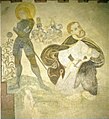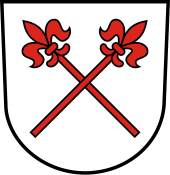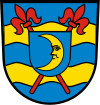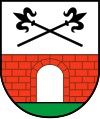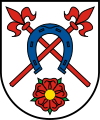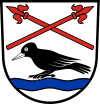Lords of Venningen

The Lords of Venningen are an old Swabian knight family that concentrated on the Kraichgau in the 14th century . The family owned property in several places around Sinsheim , provided two bishops in the 15th century and held the highest offices at the court of the Electoral Palatinate and in the Teutonic Order . Eminent family seats were on Castle Neidenstein , Eichtersheim Castle , Castle Grombach and castle Steinberg . The greatest wealth of possessions had Carl Philipp von Venningen (1728–1797), President of the Electoral Palatinate, who united the entire family property. The family continues to this day and still owns parts of their ancestral manors.
Family history
The family of the Lords of Venningen probably comes from Unterfinningen in the upper Danube region and can be documented for the first time in the 13th century as Ganerbe in Bietigheim with relatives in neighboring Remmingen . After they were ousted from Bietigheim by the Counts of Württemberg in the 14th century, representatives of the sex were found as servants of the Counts of Oettingen in Kraichgau , where the Venningen can be found in Neidenstein from 1319 and in Hilsbach from 1361 . The family was at times ramified and acquired extensive property. In 1418 they acquired the castle and village of Eschelbronn , a third of Königsbach in 1429 , the castle and village of Grombach in 1498 , Steinsberg castle in 1517 and the manor in Eichtersheim in 1541 .
The family presented with Siegfried III. († 1459) and Johann V. († 1478) bishops in Speyer and Basel, in addition, descendants of the family achieved highest offices in the Teutonic Order and at the court of the Electoral Palatinate . Important family residences from the early modern era were located in Eichtersheim, Neidenstein, Grombach and Königsbach.
From 1522/1523 the Lords of Venningen introduced the Reformation in their villages. The family was initially Lutheran, later a branch became Catholic again, which would later replace the Protestant branches that had died out in the male line.
With Ottheinrich von Venningen , the Neidensteiner line died out in 1611 and the castle and town of Neidenstein fell to the Hilsbach line, which had been at Steinsberg Castle since 1517 . In 1612 the Königsbach line also died out in the male line. The family was still widely ramified until around 1700, but as early as 1731 Carl Philipp von Venningen (1728–1797) was the last male descendant who combined all of the family's property and created a family affiliate. Two lines formed under his sons. The Hilsbacher and Neidensteiner property came to the Eichtersheimer line, which died out in 1907, whereupon the younger Grombacher line united the property, which since Carl Theodor Heribert von Venningen-Ullner von Diepurg (1806–1874) has been nicknamed Ullner von Diepurg . Carl Theodor was one of several spouses of the mistress Jane Digby , who is a common mother of all Venningens living today.
The Eichtersheim Castle in 1969 and the castle Steinberg in 1972 sold to the local municipality. The family now lives in the old headquarters at Neidenstein Castle in Kraichgau and Riegerting Castle in Upper Austria, which they acquired in 1829. The property in Grombach has been leased since the middle of the 19th century.
Significant family members

Significant personalities emerged from the Neidenstein line:
- Siegfried von Venningen († 1393), German Master of the Teutonic Order
- Johann von Venningen († 1425), Faut of Palatine Oberamts Heidelberg
- Johann von Venningen († 1432), court master of the Electoral Palatinate in Heidelberg
- Johann von Venningen († 1444), Vitztum of the Electoral Palatinate in Neustadt
- Johann V von Venningen († 1478), Bishop of Basel and founder of the university there
- Siegfried III. von Venningen († 1459), Bishop of Speyer
- Jost von Venningen († 1455), German Master of the Teutonic Order
- Margaretha von Venningen († 1505), Cistercian , abbess in the monastery Rosenthal (Palatinate)
- Stephan von Venningen († 1530), local lord in Grombach , which he acquired in 1498
- Erasmus von Venningen († 1589), court judge in Heidelberg, chief bailiff in Neuenbürg
- Ottheinrich von Venningen († 1611), Lord of Neidenstein
- Eberhard Friedrich von Venningen (1642–1710), lieutenant general of the Electorate of the Palatinate
- Carl Philipp von Venningen (1728–1797), district president and senior officer in the service of the Electorate of the Palatinate
- Friedrich Anton von Venningen (1765–1832), artistic director at the Mannheim Theater
- Karl von Venningen-Ullner von Diepurg (1866–1914), sports official
An important burial place of the Neidenstein line of the Lords of Venningen is the Evangelical Church in Neidenstein.
Possessions

Among other things, the family owned the villages Neidenstein , Daisbach (until the 15th century), Zuzenhausen , Eschelbronn , from 1498–1588 and again from 1697/1702 Grombach and from 1557 Eichtersheim . In addition there were possessions in Hilsbach , rows and other villages in the Kraichgau.
The family has also owned Riegerting Castle near Ried im Innkreis / Upper Austria since 1829 .
Steinsberg Castle in Sinsheim-Weiler
Eichtersheim Castle in the Angelbachtal between Sinsheim and Bruchsal.
Grombach Castle in Bad Rappenau-Grombach
coat of arms
Some regional coats of arms still show the crossed red lily wands (actually glazes ) on a white background of the lords of Venningen who were wealthy here. The local coats of arms in their current design were usually determined by the Baden General State Archives around 1900 and often use elements of the coat of arms of the former local nobility. The related lords of Remchingen had an inverted coat of arms with white glazes on a red background.
See also
- Master list of the Lords of Venningen
- Lords of Remchingen with inverted coat of arms
literature
- Meinhold Lurz, The Barons of Venningen , ed. from Heimatverein Kraichgau eV (special publication no. 17), Sinsheim 1997, ISBN 3-921214-13-0
- Friedrich Sander: The nobles from Venningen to Königsbach in ders .: Königsbacher Heimatbuch , Gemeinde Königsbach-Stein 1986, pp. 50–57.
- Herwig John, Gabriele Wüst: Wappenbuch Rhein-Neckar-Kreis (= Rhein-Neckar-Kreis. Historical writings. Vol. 1). Regional culture publishing house, Ubstadt-Weiher 1996, ISBN 3-929366-27-4 .
Web links
- Coat of arms in the Ingeram Codex
Individual evidence
- ^ City of Bietigheim-Bissingen (ed.): 1200 years of Bietigheim. Stages on the way to the city of today . Bietigheim 1989
- ↑ See Remminger Schlössle and Herren von Remchingen .
- ↑ http://www.habenstein.de/pb/,Lde/Heimatgeschichte.html
- ^ Roland Thomann: Destiny of a Landscape. A reader on the history of the Kraichgau and its places . Ubstadt-Weiher, 1995, p. 156.
- ^ Gert Boegner: Kraichgau. Forays through the country and history . Karlsruhe 2005 (4th edition), p. 123.
- ↑ http://burgenkunde.at/oberoesterreich/riegerting/riegerting02.htm





